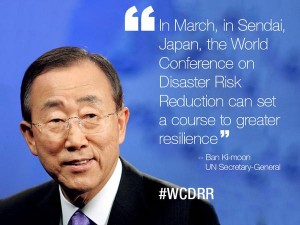 From 14-18th March, disaster professionals, politicians, UN representatives and many other stakeholders will be gathering in Sendai (Japan) at the UN World Conference on Disaster Risk Reduction. The aim of the meeting will be to agree upon the final text to replace the Hyogo Framework for Action, the UN guidelines for action on disaster risk reduction and strengthening resilience.
From 14-18th March, disaster professionals, politicians, UN representatives and many other stakeholders will be gathering in Sendai (Japan) at the UN World Conference on Disaster Risk Reduction. The aim of the meeting will be to agree upon the final text to replace the Hyogo Framework for Action, the UN guidelines for action on disaster risk reduction and strengthening resilience.
At our first annual conference, one of our speakers asked those attending to raise their hands if they’d heard of the Hyogo Framework for Action. The response was striking, concerning and important to note. Of approximately 150 students and recent graduate geoscientists in attendance – less than 25% had heard of the global framework for disaster risk reduction. The science of natural hazards that they are studying and researching, however, is central to this document, the priority actions contained within it (e.g., identify, assess and monitor disaster risks and enhance early warnings) and the cross cutting issues (e.g., multi-hazard approaches, see a later post for further comment on this). It will also be central to the soon to be published HFA 2 (see a draft of the text here)
The lack of understanding of this framework amongst a significant stakeholder community is indicative of a larger and more serious problem – the lack of understanding of what causes and drives disaster events. Geohazards teaching (especially in geology departments) is often done in isolation from any teaching on underlying vulnerability, resilience and disasters. Teaching physical volcanology without helping students understand how that information may be used and the reasons why many people live on the flanks of active volcanoes does not prepare them to make an adequate contribution to the risk reduction process. We need highly able scientists with a strong, thorough and innovative understanding of the mechanics of earthquakes, volcanoes and landslides. For this understanding to effectively feed into integrated frameworks such as the HFA and HFA2, however, those same geologists need a better understanding of how that knowledge will be used at all levels – and how the global disaster community intend to reduce the impacts of disaster events.
At Geology for Global Development we are keen to promote the very positive role that geologists will play in the coming decades to strengthen resilience and reduce the impacts of disaster events. If our contribution is to be at its best though, we must step outside our comfort zones and make an effort to understand disasters, not just hazards.
We’ll be posting other articles and recommended reading relating to this important international meeting in the coming days. Look out for those labelled HFA2.

Pingback: Geology for Global Development | Introducing our new DRR Blog Columnist…